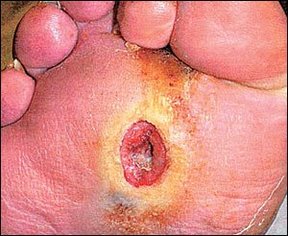Diabetic foot: Difference between revisions
| Line 4: | Line 4: | ||
==Overview== | ==Overview== | ||
[[Type 2 diabetes]] and its complications are now considered as a growing health | [[Type 2 diabetes]] and its complications are now considered as a growing health threat. It is the leading cause of [[blindness]], [[end stage renal disease]], [[coronary heart disease]] and foot ulceration which leads to [[amputation]]s. In general, the incidence of nontraumatic lower extremity amputations has been reported to be at least 15 times greater in those with diabetes than with any other medical illness. Among patients with diabetes, the lifetime risk of having foot ulcer is 15%. Diabetic foot ulcers dramatically worsen the physical, psychological and social quality of life <ref name="pmid12039404">{{cite journal| author=Assal JP, Mehnert H, Tritschler HJ, Sidorenko A, Keen H, Hellmut Mehnert Award Workshop Participants| title=On your feet! Workshop on the diabetic foot. | journal=J Diabetes Complications | year= 2002 | volume= 16 | issue= 2 | pages= 183-94 | pmid=12039404 | doi= | pmc= | url=http://www.ncbi.nlm.nih.gov/entrez/eutils/elink.fcgi?dbfrom=pubmed&tool=sumsearch.org/cite&retmode=ref&cmd=prlinks&id=12039404 }} </ref>. 1 in every 4 patients with [[diabetes]] develops complications. The pathogenesis of diabetics foot is due to two causes i.e. neuropathy and [[vasculopathy]]. Due to [[neuropathy]] the patient loses sensation whereas, vasculopathy causes poor blood supply to the foot region. Due to both these contributing factors, even a small trauma to the feet can give rise to ulcer or gangrene and may even require amputation. Thus, foot examination by a podiatrist or a doctor is recommended every year. | ||
==Diabetic Foot Physical Examination== | ==Diabetic Foot Physical Examination== | ||
Revision as of 20:03, 22 February 2013
|
Diabetes mellitus Main page |
|
Patient Information |
|---|
Editor-In-Chief: C. Michael Gibson, M.S., M.D. [1]; Associate Editor(s)-In-Chief: Priyamvada Singh, M.B.B.S. [2]; Cafer Zorkun, M.D., Ph.D. [3]
Overview
Type 2 diabetes and its complications are now considered as a growing health threat. It is the leading cause of blindness, end stage renal disease, coronary heart disease and foot ulceration which leads to amputations. In general, the incidence of nontraumatic lower extremity amputations has been reported to be at least 15 times greater in those with diabetes than with any other medical illness. Among patients with diabetes, the lifetime risk of having foot ulcer is 15%. Diabetic foot ulcers dramatically worsen the physical, psychological and social quality of life [1]. 1 in every 4 patients with diabetes develops complications. The pathogenesis of diabetics foot is due to two causes i.e. neuropathy and vasculopathy. Due to neuropathy the patient loses sensation whereas, vasculopathy causes poor blood supply to the foot region. Due to both these contributing factors, even a small trauma to the feet can give rise to ulcer or gangrene and may even require amputation. Thus, foot examination by a podiatrist or a doctor is recommended every year.
Diabetic Foot Physical Examination
Inspection
- Dilated veins
- Scar, Sinuses
- Shiny skin
- Hair distribution
- Areas of Pigmentation
- Areas of discolouration
- Varicose vein
- Ulcers
- Brittle or broken nail
- Fungal infection
Palpation
- Temperature (increase temperature- deep vein thrombosis, decrease temperature-ischemia)
- Tenderness (squeeze calf muscle and achilles tendon for tenderness)
- Pulsation- Dorsalis pedis
- Capillary filling time
- Ulcers in pressure areas like ball of great toe, base of fifth metatarsal, posterior aspect of heel
Motor Examination
- Nutrition/Bulk
- Tone
- Power
- Reflexes
Sensory
- Vibration
- Joint position sense
Video: Physical Examination Diabetes
{{#ev:youtube|715j6zRZHaA}}
Video: Diabetic Foot Care
{{#ev:youtube|DASvmFJeYX8}}
Image: Diabetic Foot Ulcer

References
- ↑ Assal JP, Mehnert H, Tritschler HJ, Sidorenko A, Keen H, Hellmut Mehnert Award Workshop Participants (2002). "On your feet! Workshop on the diabetic foot". J Diabetes Complications. 16 (2): 183–94. PMID 12039404.